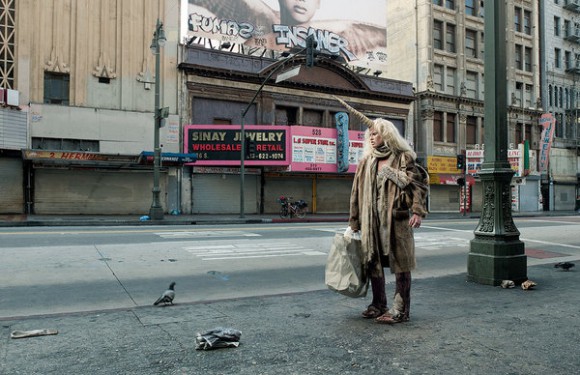JADE JACKMAN addresses Jean-Yves Lemoigne’s images of unicorn-human hybrids as a social commentary on urbanisation.
When someone says ‘unicorn’, I immediately think of my little pony and candy canes. Or, even worse still, of swooshing tails, glitter and gender stereotypes… But, Jean-Yves Lemoigne presents a new side to the history of these fictitious creatures in his ‘Urban Legends’ series.
Rather than drawing upon femininity, Lemoigne highlights another element of ‘the unicorn’ in his works. Instead, his focus is on extinction. The backgrounds for his photographs are barren urban spaces that are only occupied by his single subject, a unicorn-human hybrid. In each image, the figure wanders through half deserted streets, clutching a mottled bag of possessions. However, his subjects are individuals – that is to say, he does not re-use the same model. As a consequence, it is clear to the viewer that they are united by their species but are separated from each other by location. We can perceive the collection as a whole, but the subjects are isolated in one frame. Additionally, the brightness alters from picture to picture. The effect of this is to imply that each is taken in a different time zone. This gives the series a rather nomadic quality; this is only enhanced by Lemoigne’s choice to instruct his models to pose with their faces inclined upwards as if searching for one another across transnational boundaries.
In his works, Lemoigne beautifully articulates the void between the glamour and the squalor of urban life. In each image, Lemoigne presents us with a vision of the positives of modernity either in the form of cars or the sight of high-rise buildings in the skyline of the shot. However, for some reason or another, his subjects are left on the sidelines to traipse through the suburbs. Unicorns, who, although they are supposed to possess magical qualities, do not have the correct skill-set for the city.
Their ‘talents’ are squandered and in this modern day there are not any medieval maidens to feed them bareal sugar… (Apparently, unicorns like to eat that). Now, I am aware that I sound pretty pretentious, but the point I am trying to make is a simple one. Under the unicorn guise, Lemoigne can playfully question how the city propagates certain types and values which one must adhere to in order to fit in.
As previously mentioned, Lemoigne chooses a distinctly urban setting. Yet, we cannot name exactly where. His works summarise the soulless side of modernity. The street lamps shine, but not as a beacon of hope. They simply cast light towards the strange figure of the half-bred outsider, who has been spat out by the city. Lemoigne is clever to use the imaginary to express this sense of rejection. By doing so, he does not run the risk of glamourizing social marginalisation into something exotic to photograph. Through playing with the fictitious he provides his viewer with a poignant social commentary; his works ask us why, why have these citizens have found themselves alone. Why is there no support for these characters? Is it because they are different? Perhaps, but perhaps not, either way his work poses an interesting question about the cost of urban living.






